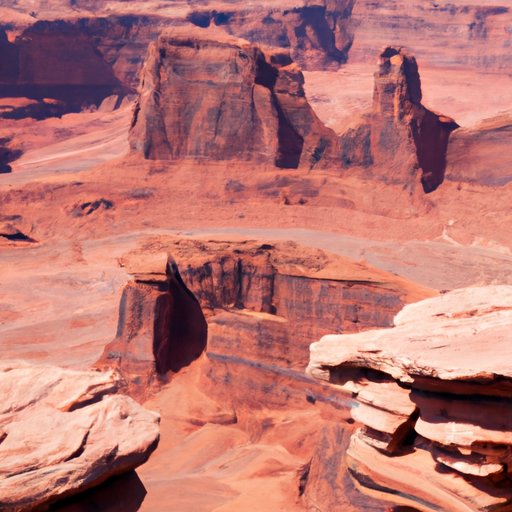I. Introduction
When we think of canyons, we tend to picture vast expanses of rugged terrain and tall rock formations that seem to touch the sky. These geological wonders are not just visually stunning, but also have a rich history and diverse ecology. In this article, we will explore the world of canyons from the various factors that contribute to their formation to the unique flora and fauna that thrive in these environments. Whether you’re an experienced outdoor enthusiast or simply someone who appreciates nature’s beauty, this article has something to offer.
II. A Geological Wonder
So what exactly is a canyon? A canyon is a deep, narrow valley with steep sides often carved by a river or erosion. The steep sides offer a window into the geological history of the earth. There are many factors involved in the formation of canyons, such as tectonic activity, water erosion, and wind erosion. One of the most famous canyons is the Grand Canyon in Arizona, USA, which is 277 miles long, up to 18 miles wide and 6,093 feet deep. Another unique canyon is the Antelope Canyon in Arizona, which was formed by the erosion of Navajo sandstone and has beautiful undulating rock formations.
III. The Grandeur of Canyons
The beauty of canyons is hard to describe in words, but it can be easily captured in photographs. Canyon photography, especially when capturing the light at different times of day, can create a beautiful kaleidoscope that makes the canyon come alive. You can capture the colors of the rock formations and the shadows that the sunlight creates. Many of the world’s most iconic canyons such as the Antelope Canyon, Bryce Canyon in Utah, USA, and the Fish River Canyon in Namibia, leave visitors speechless. Additionally, the geological history of canyons is often just as fascinating as their visual appeal. For instance, the Bryce Canyon is unique, as it is made up of a series of multi-colored rock formations called “hoodoos” that seem to glow in the light at different times of day.
IV. Life in the Canyon
Canyons are home to a diverse range of flora and fauna, which have developed unique adaptations to thrive in such an environment. For example, the California Condor is a rare bird species that is found in the Grand Canyon and is one of the largest birds in North America. Similarly, the Joshua tree is a unique type of tree that grows in canyons and is a symbol of the Mojave Desert. These plant and animal species are uniquely adapted to living in the harsh and rugged environment of canyons. Further, you can also find rich ecosystems in and around waterways in canyons, with aquatic insects creating a vital food source for fish such as salmon and trout.
V. A Journey Through Time
Canyons have been a staple of human culture and society since ancient times due to their beauty, natural resources, and adaptations for survival. Historically, canyons provided shelter, water, and food for indigenous peoples, making them critical for survival. Nowadays, canyons are used for various outdoor activities ranging from hiking to rock climbing, camping, and even river rafting. They also hold immense spiritual significance with cultures such as the Native Americans designating canyons as sacred spaces.
VI. Navigating the Unknown
Canyon exploration can be a thrilling and unforgettable adventure. However, it is important to take precautions and be prepared for the risks involved. If you’re not an experienced outdoor enthusiast, it is recommended to take a guided tour or course to learn about the terrain and safe practices. Additionally, it’s important to carry appropriate gear and equipment such as a first-aid kit, water, navigation tools, and warm clothing in case of emergency. Lastly, check the weather forecast before starting the adventure, as rain can lead to flash floods in canyons, creating potentially dangerous conditions for hikers.
VII. Conclusion
In conclusion, canyons are unique and awe-inspiring natural formations that offer many opportunities for exploration, adventure, and learning. From the Grand Canyon in Arizona to the Fish River Canyon in Namibia, each canyon has its own story and secrets waiting to be discovered. Whether for their natural beauty or the history they hold, canyons are an essential part of both human and natural systems.
